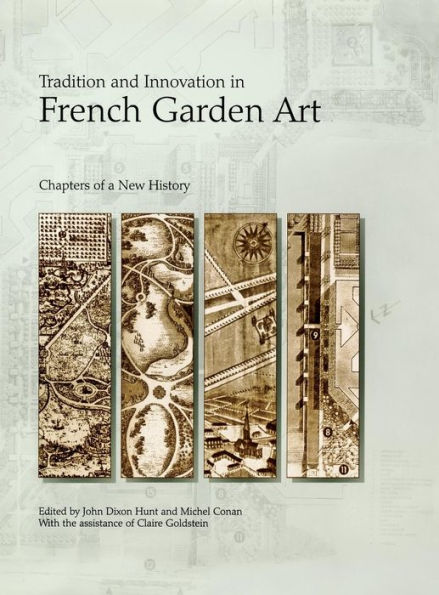Tradition and Innovation in French Garden Art: Chapters of a New History
In the absence of any modern history of French garden art, this volume offers twelve chapters that review some of the most interesting and innovative moments of French garden history. This series of studies traces a progression from what is taken as the golden age of French garden art, in the late seventeenth century, up to the present, when a renaissance of French design theory and practice is clearly visible.
By exploring the contributions of such important designers as Jean-Marie Morel and Claude-Henri Watelet, these essays argue for a tradition that includes, but is by no means exclusively influenced by, Andre Le Notre, long considered the dominant figure in French garden history. Even a glance at the wealth of garden theory and practice during the late eighteenth and early nineteenth centuries must call into question the conventional neglect of post-Le Notrean work. Each author reads a significant moment of garden art in relation to a whole cluster of cultural concerns, which change with the time and place of the garden discussed; overall, this has meant invoking town planning, engineering, optics, scientific and philosophic movements, bourgeois ethics, foreign imports, vernacular workings of the land, the rise of professional landscape practice, even the modernist refusal to recognize the garden itself as the prime site of intervention in the landscape.
1101955105
By exploring the contributions of such important designers as Jean-Marie Morel and Claude-Henri Watelet, these essays argue for a tradition that includes, but is by no means exclusively influenced by, Andre Le Notre, long considered the dominant figure in French garden history. Even a glance at the wealth of garden theory and practice during the late eighteenth and early nineteenth centuries must call into question the conventional neglect of post-Le Notrean work. Each author reads a significant moment of garden art in relation to a whole cluster of cultural concerns, which change with the time and place of the garden discussed; overall, this has meant invoking town planning, engineering, optics, scientific and philosophic movements, bourgeois ethics, foreign imports, vernacular workings of the land, the rise of professional landscape practice, even the modernist refusal to recognize the garden itself as the prime site of intervention in the landscape.
Tradition and Innovation in French Garden Art: Chapters of a New History
In the absence of any modern history of French garden art, this volume offers twelve chapters that review some of the most interesting and innovative moments of French garden history. This series of studies traces a progression from what is taken as the golden age of French garden art, in the late seventeenth century, up to the present, when a renaissance of French design theory and practice is clearly visible.
By exploring the contributions of such important designers as Jean-Marie Morel and Claude-Henri Watelet, these essays argue for a tradition that includes, but is by no means exclusively influenced by, Andre Le Notre, long considered the dominant figure in French garden history. Even a glance at the wealth of garden theory and practice during the late eighteenth and early nineteenth centuries must call into question the conventional neglect of post-Le Notrean work. Each author reads a significant moment of garden art in relation to a whole cluster of cultural concerns, which change with the time and place of the garden discussed; overall, this has meant invoking town planning, engineering, optics, scientific and philosophic movements, bourgeois ethics, foreign imports, vernacular workings of the land, the rise of professional landscape practice, even the modernist refusal to recognize the garden itself as the prime site of intervention in the landscape.
By exploring the contributions of such important designers as Jean-Marie Morel and Claude-Henri Watelet, these essays argue for a tradition that includes, but is by no means exclusively influenced by, Andre Le Notre, long considered the dominant figure in French garden history. Even a glance at the wealth of garden theory and practice during the late eighteenth and early nineteenth centuries must call into question the conventional neglect of post-Le Notrean work. Each author reads a significant moment of garden art in relation to a whole cluster of cultural concerns, which change with the time and place of the garden discussed; overall, this has meant invoking town planning, engineering, optics, scientific and philosophic movements, bourgeois ethics, foreign imports, vernacular workings of the land, the rise of professional landscape practice, even the modernist refusal to recognize the garden itself as the prime site of intervention in the landscape.
84.95
In Stock
5
1

Tradition and Innovation in French Garden Art: Chapters of a New History
256
Tradition and Innovation in French Garden Art: Chapters of a New History
256Hardcover
$84.95
84.95
In Stock

Product Details
| ISBN-13: | 9780812236347 |
|---|---|
| Publisher: | University of Pennsylvania Press, Inc. |
| Publication date: | 05/27/2002 |
| Series: | Penn Studies in Landscape Architecture |
| Pages: | 256 |
| Product dimensions: | 8.80(w) x 11.10(h) x 0.90(d) |
About the Author
From the B&N Reads Blog
